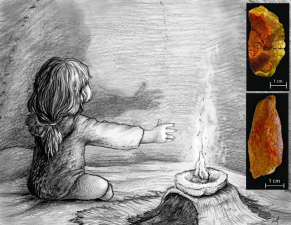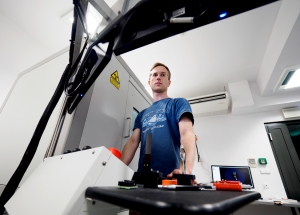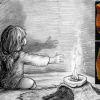The past to the future, or how physicists study the functioning of the first Homo Sapiens cultures
2021.12.21 14:24 - Marek PawłowskiThe end of the year is a good time in research institutions to recall the particularly interesting results achieved in the previous twelve months. These undoubtedly include those that are the result of collaboration between scientists of various specialties. Their example is the joint work of archaeologists, chemists and physicists on the archaeological site in Ćmielów, published last year.
Scientists from NCBJ in cooperation with other researchers analyzed the monuments of material culture of the late Palaeolithic community, belonging to the circle of the Magdalenian culture (18 to 11 thousand years ago), discovered near Ostrowiec Świętokrzyski in Ćmielów. This culture, traces of which have been found in many places in Western and Central Europe, is more widely known for the creation of cave rock art. from the region of France (Lascaux cave) and Spain (Altamira cave). In the territory of present-day Poland, traces of its functioning have been noted, among others in the form of a camp in an „open” area. Physico-chemical tests of the objects from the site in Ćmielów were carried out in 2020 and focused on presenting the aspects of the functioning of former hunter-gatherer communities.
Specialist research concerned, among others, fragments of stone material (chalcedonite) found during excavations in the years 2004-2009. The archaeological site of Ćmielów 95, located on the Mały Gawroniec hill of the Sandomierz Upland, is an area of over 4 ares, where over 17.5 thousand artifacts and other traces of the Magdalenian culture from the Paleolithic era were found. The researchers attention was particularly drawn to small fragments (6.7 cm x 3.9 cm x 3.3 cm and 3.7 cm x 2.2 cm x 3.3 cm) of larger objects, but the found elements were too small to reconstruct the original their shape and define their purpose.
Before specialist analyzes carried out with the participation of NCBJ researchers, it was considered that these were fragments of lighting lamps in which the fuel was organic material (including moss, lichen and animal fat). Such lamps are commonly known from the areas of West Magdalenian, where they were used to illuminate cave camps. Another working hypothesis was their use as a raw material for the production of red ocher, known as a ritual dye since the Neanderthal period, and used as a dye also in later and present art.
When analyzing the functions of stone objects, researchers used the multi-instrumental methodology. Computed tomography was used to visualize the 3d structure, Raman spectroscopy and gas chromatography with mass spectrometry to capture the structure of the residual burnt organic material. Tests with the use of X-ray diffraction and an electron micro-probe were also performed in order to analyze thermal changes and the temperature range in which the material worked.
Based on the conducted archaeometric research, supported by data obtained from the experiment, the origin of Palaeolithic objects Was determined and it Was discovered that these are fragments of heating plates used to heat meat dishes in an open hearth, the so-called cooking-stones. The research allowed to estimate that the applied meat processing temperatures reached 800ºC, and the used stone raw material came from a quarry located 5 km from the camp in Ćmielów.
„Archaeometric research with the use of physicochemical tools of the Magdalenian material from Poland is being carried out successively,” says Dr Ewelina Miśta-Jakubowska from the NCBJ Department of Physics and Particle Acceleration Techniques, who conducts research using physico-chemical methods. „Apart from the archaeological material from Ćmielów, where there are numerous ocher finds and stone plaques with traces of sunburn that require functional and origin interpretation, we have at our disposal material from the Rydno reserve and a newly discovered site near Białystok, where a burial with ritual ocher Was found, which is currently under analysis conducted with the participation of researchers from NCBJ. Physico-chemical research of archaeological material allows answering questions about the origin of artifacts (and thus the mobility of our ancestors), their application and verification of hypotheses based on issues beyond the scope of conventional archaeological methodology. Such research is a perfect synergy of the natural sciences and the humanities and allows for the construction and completion of history anew. "
http://www.archeologia.uw.edu.pl/Cmielow_95/index.html
Research carried out as part of the funding obtained from the Ministry of Culture and National Heritage for the project entitled On the border of the worlds. The Magdalenian culture camp in Ćmielów, voiv. Świętokrzyskie (501/73 / DOC-800).




















